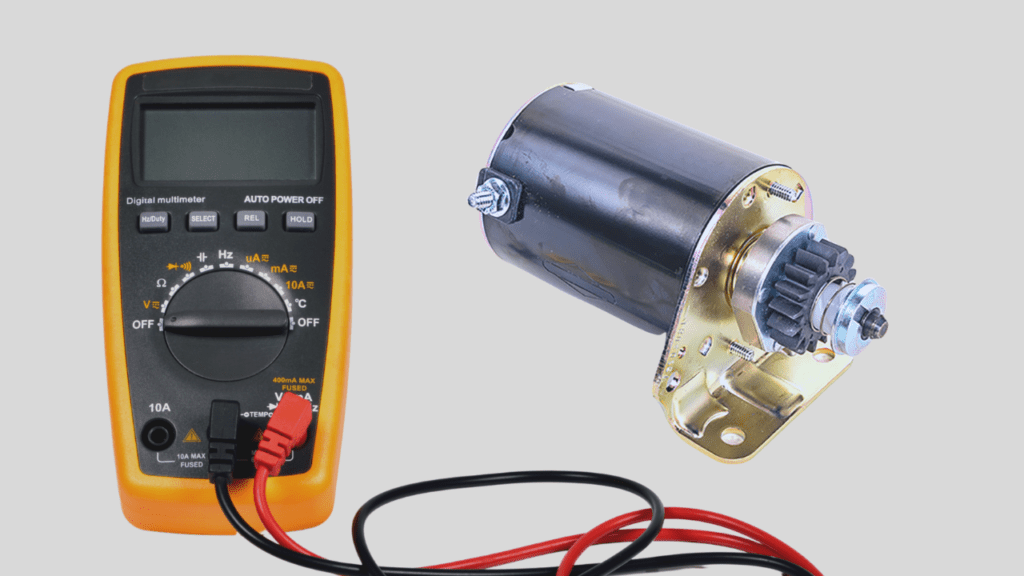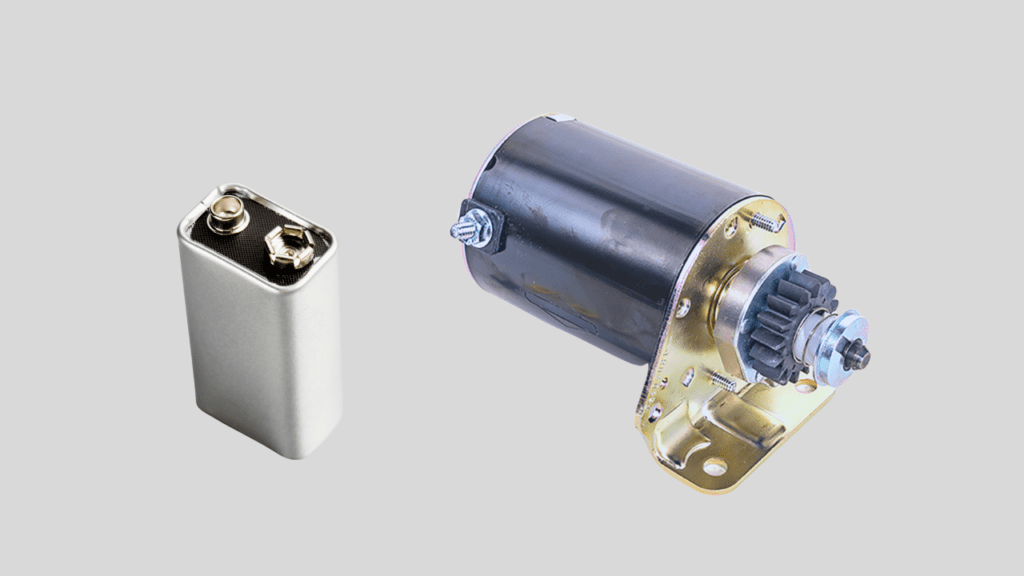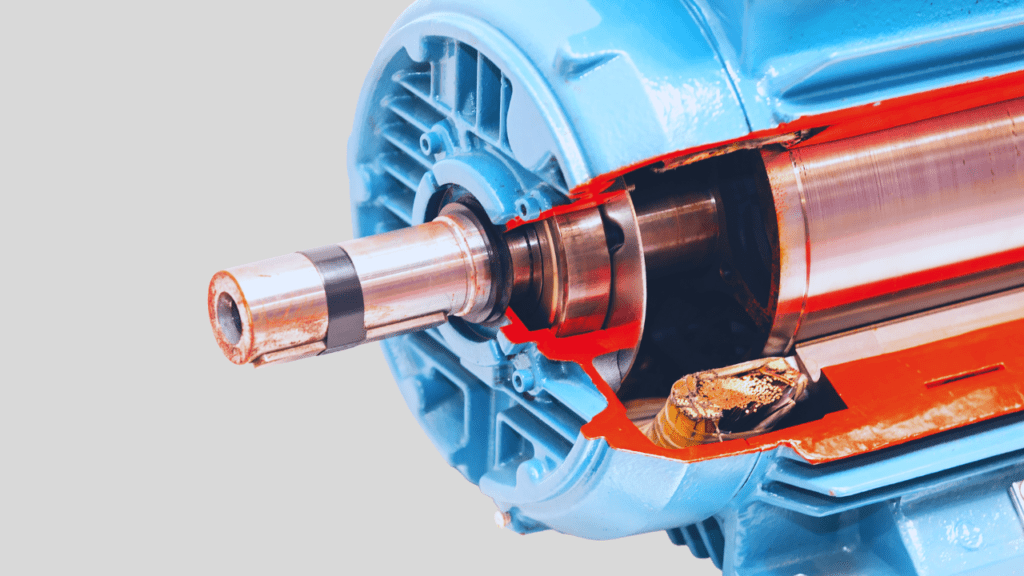How To Test A Lawn Mower Starter
It’s the rainy season now and, as expected, you need to mow the lawn repeatedly to keep your home looking good.
However, you have noticed that your lawn mower’s engine produces a clicking sound when you attempt to switch it on, stops intermittently, or is irresponsive to ignition start attempts.
All these point to a problem with the starter. We have prepared a complete guide on how to test a lawn mower starter so you don’t have to look any further.
Let’s get right in.

Tools Required To Test Lawn Mower Starter
To check a lawnmower starter for issues, you will need
- A multimeter,
- A fully charged 12-volt battery,
- A socket or combination wrench,
- A screwdriver,
- Three to four jumper cables
- Protective equipment like rubber insulated gloves and safety goggles.
How To Test a Lawn Mower Starter
After making sure the battery is fully charged and the wires are free of dirt and corrosion, connect a jumper cable from the negative battery post to any metal part of the starter and connect another cable from the positive post to the starter terminal. If you hear a clicking sound, the starter is bad.
These steps will be expatiated on further.
- Check and Charge The Battery
The lawnmower starter is powered by the engine battery and would not work properly if the battery isn’t sufficiently charged or in good condition.
You may check how much voltage you have in the battery with a multimeter to determine this.

Turn the multimeter to the 20DC voltage range represented by “VDC” or “V–” (with three dots), place your red probe on the positive battery post and place the black probe on the negative battery post.
If the multimeter presents you with a value lower than 12 Volts, then you should charge the battery.
After charging, check whether the battery presents you with the right voltage reading. If it doesn’t, then it could be why the engine isn’t starting.
Additionally, if you have the battery reading 12 volts or higher, then try to start the lawn mower.
If the lawn mower still doesn’t start up, then you proceed to the next step. It is important to note that a fully-charged battery supplying 12 volts is required to successfully diagnose a lawn mower in the subsequent tests to be described.
- Inspect Connections For Dirt And Corrosion
Your lawnmower starter may not be working because there is dirt interrupting its electrical circuit.
What you do next is to detach the battery connectors from their posts using a wrench and inspect all the electrical wires and terminals of your battery, starter solenoid, and starter motor for any form of contamination.
Use an iron or wire brush to clean out any sediments from all the wires and connection terminals, connect the battery cables back using the wrench, then check to see whether the starter works.
If it works when clean, then dirt was affecting the lawnmower’s electrical circuit. If it doesn’t switch on when clean, you proceed to check the starter itself using the battery and jumper cables.
One other way you may check your electrical wires is with the use of a multimeter. You run a resistance or continuity test on a wire by putting the multimeter in the Ohm setting and placing one probe on each end of the wire.
Any reading higher than 1 Ohm or the multimeter showing “O.L” means the cable is faulty and you should replace it. Nonetheless, you may proceed to the next step.
- Disconnect Battery
Now, you want to boycott the whole stream of electrical connectors leading from the battery to the starter to directly diagnose it.
Disconnect the battery cables with a wrench, set the fully-charged battery aside, and get yourself jumper cables. Jumper cables are connector wires that have two clamps on both ends.
- Take Protective Measures
From this point on, we will be dealing with potential shock hazards, so you make sure you take measures to protect yourself.
For our tests, wearing a rubber insulated glove is enough protection for you. It helps when dealing with jumper cables, as these typically produce high-voltage sparks. You may also wear safety goggles.
- Attach Jumper Cables To Starter Solenoid
The starter solenoid is one of the important parts of the lawn mower ignition system, as it receives and supplies the right amount of voltage to the starter motor. The solenoid is a typically black component mounted on the body of the starter that has two large terminals or “lugs”
A usually red cable comes from the battery and connects to one lug, while another black cable goes from the other lug and connects to a terminal on the starter.
What we do now is to make direct connections between the battery and solenoid, as well as the solenoid and starter, using jumper cables.
You may need a metal screwdriver and about three to four jumper cables for this. Attach one end of a jumper cable to your positive battery post and attach the other end to the solenoid lug receiving power from the battery.
Next, to ground the connection, attach one end of another jumper cable to the negative battery post and attach its other end to any idle metal part of the starter.
Once this is done, attach one end of a third jumper cable to the other solenoid lug and its other end to the starter terminal receiving it.
Finally, either use a screwdriver or jumper cable to bridge or connect the two solenoid lugs to each other. When using a screwdriver, make sure the part you hold on to is properly insulated.
- Check For Motor Spin After Solenoid Bridging
It’s time for our first evaluation. If the starter spins when you bridge the two large solenoid lugs, then the solenoid is faulty and should be replaced. On the other hand, if the starter motor does not spin when you make this connection, then the starter could be why the engine is not starting.
Our next steps help you to directly test the starter to see if it is faulty or not.
- Attach Jumper Cables Directly To Starter
Now you want to make direct connections from the battery to the starter.
With all your previous connections for the solenoid test detached, you connect one end of a jumper to your negative battery post and then the other end to an idle metal part of the starter to ground the connection.
Next, connect one end of a second jumper cable to your positive battery post and connect its other end to the starter terminal that is supposed to receive power from the solenoid. Make sure all your connections are sturdy and not loose.
- Look For Motor Spin After Jumping Starter
This is our final evaluation. At this point, the starter motor is expected to spin if the starter is in good condition. If the motor does not turn, then you have confirmed that the starter is faulty and needs to be replaced.

If the motor attempts to turn but stops and produces a clicking sound, then the solenoid has a problem. This direct starter test helps you take care of the two testing processes.
Testing A Starter Solenoid Could Be Dangerous
Starter solenoids draw about 8 amps to 10 amps from the lawn mower battery to power the starter motor. For comparison, a current of 0.01 amps is enough to cause you severe pains, and a current of more than 0.1 amps is enough to be fatal.
A 10 amp-current is a hundred times more than this, which is a good reason why you should always wear protective equipment while testing with the use of jumper cables.
Conclusion
Diagnosing your lawnmower starter for issues could go from very easy procedures like checking the battery for charge and wires for corrosion to intricate processes like jumpstarting the motor.
Make sure you take all protective measures and replace all faulty parts with new pieces that have the same specifications. You may also check our guides on testing a car starter and also testing a car solenoid with a multimeter.
FAQ
How Do I Know If The Starter On My Lawn Mower Is Bad?
Some of the symptoms of a faulty starter include a clicking or cranking noise in a failed attempt to switch on the engine, periodic stops, or a total lack of responsiveness of the engine.
What Causes A Lawn Mower Starter Not To Engage?
A lawn mower starter may be irresponsive if the battery is bad or weak, there are wiring problems within the circuit, the motor Bendix isn’t working with the flywheel, or the solenoid has gone bad.

Author
Alex Klein is an electrical engineer with more than 15 years of expertise. He is the host of the Electro University YouTube channel, which has thousands of subscribers.
